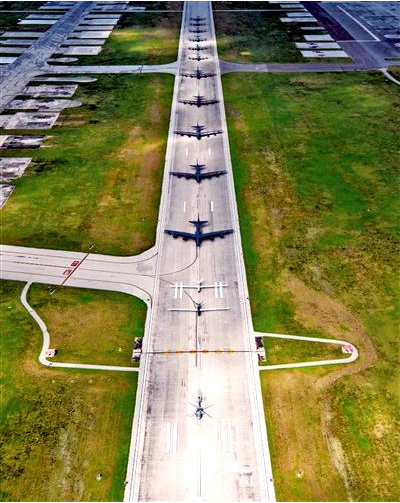
The US military’s recent ground parade in Guam, a procession of military aircraft taxiing in a formation right before a minimum interval takeoff known as an “elephant walk”, sparked extensive speculations. The parade was analyzed by some media as a move to demonstrate its military’s deterrence and sufficient combat force in the Asia-Pacific region despite the COVID-19 pandemic.
US military’s elephant walk in Guam carries deep overtones.
As the spacing between the participating aircraft is less than the minimal takeoff separation, the elephant walk in Guam is generally considered “more for show than for real combat” and carries deep overtones.
First, it’s meant to turn the tide on the Guam trust crisis. As an important outpost of the US military in the Pacific Ocean, Guam is of great value both in terms of geography and the stationing of troops. After the COVID-19 broke out globally early this year, the Governor of Guam Leon Guerrero promoted her island as an “island paradise” that was “coronavirus free”, which, however, was soon refuted by the fact that Guam became the “epicenter” of the pandemic spreading in the US Navy, as reported by New York Times. As the governor declared a state of emergency across the island on March 14, safety of the military personnel at Naval Base Guam was brought to public attention in US. To a large extent, the ground parade was conducted to address this concern.
Second, it serves as demonstration of US combat readiness. The widespread COVID-19 pandemic has taken a heavy toll on the US military’s war preparedness. The US Secretary of Defense Mark Esper decided to put a halt on the movement of all overseas American service members before mid-May, the rotation of 2,500 US marines to Darwin, Australia was postponed indefinitely, whether the Rim of the Pacific Exercise (RIMPAC) will take place on schedule is uncertain, and COVID-19 cases have been confirmed on four aircraft carriers of the Pacific Fleet. All these have led the US military’s war preparedness to be seriously questioned, which is partly the reason why it exhibited its advanced aircraft in Guam - to showcase its readiness to fight in response to doubts.
Third, it showcases America’s resolve to return to the Asia Pacific. The US Indo-Pacific Command head Adm. Phil Davidson recently submitted to the Congress a report on what’s needed to enhance American presence in the Asia Pacific that requested USD20 billion over six years, sending a strong signal that the Pentagon is shifting its focus to the Asia Pacific. In contrast, the importance of the region and the US military’s combat capability there has been doubted both within and outside the country. Australian scholar Ashely Townshend recently published an article, saying that the US troops in the Asia Pacific are barely holding up in face of the "stricken warships, stalled deployments and Washington’s acute preoccupation with its own poorly handled humanitarian crisis". The muscle-flexing in Guam is both to root for Davidson’s report and to demonstrate the importance attached by the Pentagon to this region.
US military’s frequent muscle-flexing calls for an alert.
It’s possible that Guam will come to a tougher time after the parade of elephant walk, and America’s constant muscle-flexing in the Asia Pacific calls for high alert.
On the one hand, Guam may come to a hard time. According to USNI news, 950 sailors onboard the USS Roosevelt aircraft carrier berthing at Guam had tested positive for COVID-19 as of April 14, constituting 62% of confirmed cases in the US Navy. As Guam is under the double pressure of preventing imported cases from American soldiers and clustered infections on the island, the local medical and public emergency systems are under a lot of strain. Moreover, the safety of American troops at the Andersen Air Force Base and the Naval Base Guamin Apra Harbor may be subject to greater threats, potentially affecting the combat-readiness activities.
On the other hand, the Asia-Pacific region is exposed to more uncertainties. The show of elephant walk on Guam was intended to tell the world that the US military still views the Asia Pacific as the main battlefield where major powers compete even in the most difficult times. Going forward, as the items on the $20billion wish list are fulfilled, the US military’s capability of carrying out all-terrain combats encompassing the land, sea, air, space, and cyber domain, combined combats of various services and coordinated operations with allies in the region will be significantly enhanced. In the next step, the US military is likely to adopt more aggressive, even provocative, steps in the region, which will create more uncertainties for the regional situation.











